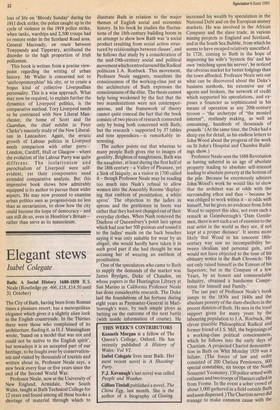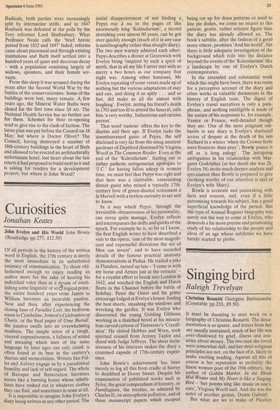Elegant stews
Isabel Colegate
Bath: A Social History 1680-1850 R.S. Neale (Routledge pp. 466, £18, £14.50 until 31 October) The City of Bath, having been from Roman times a pleasure resort, has a metropolitan elegance which gives it a slightly alien look in the English countryside. In the Thirties there were those who complained of its architecture, finding it, as H.J. Massingham wrote, 'based on a model that was not and could not be native to the English spirit', but nowadays it is an accepted part of our heritage, to be fought over by conservationists and visited by thousands of tourists and written about in, Professor Neale says, a new book every four or five years since the end of the Second World War.
Professor Neale, now at the University of New England, Arrnidale, New South Wales, taught at Bath Technical College for 12 years and found among all these books a shortage of material through which to illustrate Bath in relation to the major themes of English social and economic history. In his book he studies the fluctua tions of the 18th-century building boom in an attempt to show how Bath was `a social product resulting from social action structured by relationships between classes', and he follows that study by a consideration of the mid-19th-century social and political movement which centred around the Radical politician LA. Roebuck. This movement, Professor Neale suggests, manifests the consciousness of the working-class just as the architecture of Bath expresses the consciousness of the elite. The thesis cannot help being weakened by the fact that the two manifestations were not contempor aneous, and the framework of theory cannot quite conceal the fact that the book consists of two pieces of research connected only by being both concerned with Bath; but the research — supported by 37 tables and nine appendices,— is remarkably interesting.
The author points out that whereas to many people Bath gives rise to images of gentility, Brighton of naughtiness, Bath was the naughtier, at least during the first half of the 18th century — a Valley of Pleasure, yet a Sink of Iniquity, as a visitor in 1700 called it — though Professor Neale may be reading too much into Nash's refusal to allow women into the Assembly Rooms 'display ing that emblem of prostitution, a white apron'. The objection to the ladies in aprons and the gentlemen in boots was rather that they had not changed out of their everyday clothes. When Nash removed the Duchess of Queensbury's point lace apron which had cost her 500 guineas and tossed it to the ladies' maids on the back benches saying it was only suitable for wear by an abigail, she would hardly have taken it in such good part if she had thought he was accusing her of wearing an emblem of prostitution.
One of the speculators who came to Bath to supply the demands of the market was James Brydges, Duke of Chandos, on whose papers in the Huntington Library at San Marino in California Professor Neale has done considerable research. The Duke laid the foundations of his fortune during eight years as Paymaster-General in Marlborough's wars, by such simple ploys as betting on the outcome of the next battle (with inside information of course). He increased his wealth by speculation in the National Debt and oti the European money markets. He was involved in the African Company and the slave trade, in various mining projects in England and Scotland, and in the South Sea Bubble, from which he seems to have escaped relatively unscathed. In 1726, coming to Bath in the hope of improving his wife's 'hysteric fits' and his own 'twitching upon his nerves', he noticed the obvious market for better lodgings than the town afforded. Professor Neale sets out what can be discovered about the Duke's business methods, his extensive use of agents and brokers, the network of credit which supported his speculations, and exposes a financier as sophisticated in his means of operation as any 20th-century tycoon — 'the archetype of "the monied interest", restlessly making, as well as consuming, hundreds of thousands of pounds.' (At the same time, the Duke had a sharp eye for detail, as his endless letters to John Wood about the progress of the work on St John's Hospital and Chandos Buildings show.) Professor Neale sees the 1688 Revolution as having ushered in an age of absolute property leading to absolute self-interest leading to absolute poverty at the bottom of the pile. Because he enormously admires John Wood's work he would like to show that the architect was at odds with the surrounding ethos and thus — because he was obliged to work within it — at odds with himself, but he gives no evidence from John Wood to support this idea, not even such a remark as Gainsborough's 'Dam Gentlemen, there is not such a set of enemies to the real artist in the world as they are, if not kept at a proper distance'. It seems more likely that Wood in his innocent 18thcentury way saw no incompatibility between idealism and personal gain, and would not have objected to the tone of his obituary notice in the Bath Chronicle: 'He not only raised himself in the Esteem of his Superiors; but in the Compass of a few Years, by an honest and commendable Industry, obtained a handsome Competence for himself and Family.'
The last part of Professor Neale's book jumps to the 1830s and 1840s and the absolute poverty of the slum-dwellers in the poorer districts of Bath. He sees in the loyal support given for many years by the labouring population to J.A. Roebuck, the clever irascible Philosophical Radical and former friend of J.S. Mill, the beginnings of a working-class political consciousness, which he follows into the early days of Chartism. A projected Chartist demonstration in Bath on Whit Monday 1839 was a failure. (The forces of law and order consisted of 200 Chelsea Pensioners, 600 special constables, six troops of the North Somerset Yeomanry, 130 police armed with cutlasses and two troops of Hussars called in from Frome. In the event a sober crowd of about 3,000 gathered in a field outside Bath and soon dispersed.) The Chartists never did manage to make common cause with the Radicals, both parties were increasingly split by internecine strife, and in 1847 Roebuck was defeated at the polls by the Tory reformer Lord Shaftesbury. What Professor Neale calls the 'brief heroic period from 1832 and 1847' faded, reforms came about piecemeal and through existing institutions and Bath itself settled into a hundred years of quiet and decorous decay — with a population consisting largely of widows, spinsters, and their female servants.
From this sleep it was aroused during the years after the Second World War by the battles of the conservationists. Some of the buildings were lost, many remain. A.. few years ago, the Mineral Water Baths were closed for the first time since $4 AD. The National Health Service has no further use for them. Schemes for their re-opening tend to give rise to the clash of faction. The latest plan was put before the Council on 18 May; but where is Doctor Oliver? The Council, having destroyed a number of 18th-century buildings in the heart of Bath and allowed to be erected an architecturally unfortunate hotel, lost heart about the law courts it had proposed to build next to it and is asking for tenders for a development project; but where is John Wood?











































 Previous page
Previous page